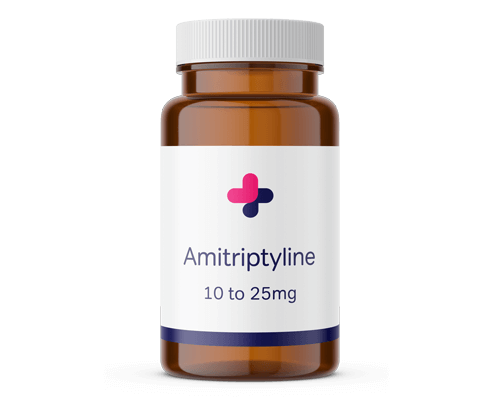Amitriptyline side effects
Common side-effects of amitriptyline:
- Dry mouth
- Weight gain
- Constipation
- Sedation
- Fatigue
- Blurred vision
- Nausea and vomiting
- Weakness
- Changes in sex drive or ability
- Confusion
- Excessive sweating
- Headaches
- Unsteadiness
- Difficulty urinating
- Pain in hands and/or feet
If any of these side-effects persist or manifest themselves in a severe way, consult your primary care physician or prescriber.
Potential serious side-effects include:
- Increase or emergence of depression and/or suicidal thoughts and behavior:
- Amitriptyline is, first and foremost, an antidepressant. There are some studies suggesting that anti-depressants may have worsening effects on depression and suicidality. Patients using antidepressants should be monitored closely for worsening symptoms such as suicidal ideation and unusual changes in behavior, especially during the first months of usage. Call a healthcare provider right away if you or someone you know experiences any of the following symptoms, especially if they are new or have worsened: suicidal thoughts, suicide attempts, depression, anxiety, agitation, restlessness, panic attacks, insomnia, irritability, aggressive behavior, dangerous impulses, mania, other unusual behavior, eye pain, changes in vision, swelling or redness around the eye.
- Cardiac dysrhythmias such as tachycardia (when your heart rate exceeds the normal resting rate. Usually, a resting rate over 100 beats per minute is considered tachycardia)
- Changes in atrioventricular (AV) conduction (Pertaining to the atria, the upper chambers of the heart and the ventricles, the lower chambers of the heart)
- Heart block (a condition where the heart beats more slowly or with an abnormal rhythm)
- Hallucinations (when a person experiences something that does not exist outside of their mind, for example, seeing, hearing, smelling, tasting or feeling things that are not actually there)
- Slow or difficult speech
- Crushing or heavy chest pain
- Severe skin rash
- Swelling of the tongue and face
- Yellow skin or eyes (jaundice)
- Jaw, neck, and back muscle spasms
- Unusual bleeding
- Uncontrollable shaking of a body part
- Seizures
If you experience any of these severe side-effects, contact your doctor immediately or go to an emergency room right away.
Contraindications
- Patients who have shown prior hypersensitivity to Amitriptyline.
- Patients who take monoamine oxidase inhibitors. Hyperpyretic crises, severe convulsions and deaths have occurred in patients who have ingested monoamine oxidase inhibitors and amitriptyline at the same time. If the patient wants to replace monoamine oxidase inhibitors with amitriptyline hydrochloride, the 14 days should be allowed to elapse before replacing medication. Amitriptyline hydrochloride should then be used cautiously and with gradual increase in dosage until achieving an optimal response.
- Patients recovering from myocardial infarction.
- Patients during the manic phase of bipolar disorder.
Patients should consult their physicians and use amitriptyline with caution if they have a history of cardiovascular disease, chronic constipation, diabetes, epilepsy, bipolar disorder, psychosis, hyperthyroidism, increased intra-ocular pressure, suicidal behavior, pheochromocytoma, prostatic hypertrophy, susceptibility to angle-closure, glaucoma, urinary retention.
Drug interactions
Some drugs may interfere with the effects of Amitriptyline. Do not take Amitriptyline at the same time as the following drugs: Arbutamins, Disulfiram, thyroid supplements, NSAIDs (such as Ibuprofen), blood thinners (such as Warfarine), anticholinergic drugs (such as Benztropin, Balladonna, Alkaloids), certain drugs for high blood pressure (such as Clonidine, Guanabenz, and Resperine), Monoamine Oxidase Inhibitors (such as Isocarboxazid, linezolid, Methylene Blue, Moclobemide, Phenelzine, Procarbazine, Rasagiline, Safinamide, Selegiline, Tranylcypromine), Cimetidine, Terbinafine, drugs to treat irregular heart rate (such as Quinidine, Propafenone, Flecainide), antidepressants (such as SSRIs including Paroxetine, Fluoxetine, Fluvoxamine), antihistamines (such as Cetirizine, Diphenhydramine), drugs for sleep or anxiety (such as Alprazolam, Diazepam, Zolpidem), muscle relaxants, and narcotic pain relievers (such as Codeine). Always inform your doctor of the medications you are taking before using this Amitriptyline.
Can I use Amitriptyline when pregnant or breastfeeding?
There is little data on whether pregnant women can use Amitriptyline, but it has been shown to cross the placenta, although the effects of this have not been adequately studied. Generally, it is not recommended unless absolutely necessary. In this case, very careful consideration is necessary of both risks and benefits. Do not self-medicate if you are pregnant but talk to your health physician. Regarding breastfeeding, risks to the baby must be considered as Amitriptyline and its metabolites are emitted into breast milk. Due to the benefits of the breast milk for the child in contrast to the benefits of the therapy for the mother, a decision on whether to continue or abort the therapy should be carefully taken with the help of a physician.
Does Amitriptyline affect fertility?
Some clinical studies on animals have shown reproductive toxicity. However, there are no data on the repercussions of Amitriptyline for human fertility.

















Quick and discreet
I ordered Azithromycin tablets for chlamydia treatment, received it next day in a brown discreet pack, and cheaper than all other pharmacies, can't ask for more
Jordan McCann